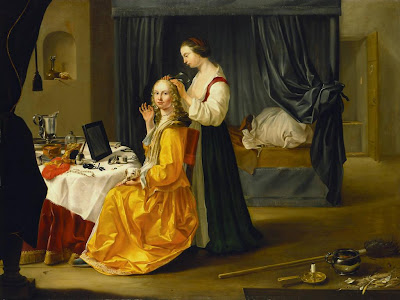 |
| Lady at Toilette, Utrecht school, 17th century Click on the link for a fun article on 17th century beauty. |
Today I have a 17th century
perfume recipe for you, taken from Polygraphice by William Salmon, published in 1685.
The recipe
To make Cyprian Powder.
Gather Musk moss of the Oak in December, January or Februarys
wash it very clean in Rose-water, then dry it, steep it in Rose-water for
two days, then dry it again, which do oftentimes: then
bring it into fine Powder and fierce it: of which
take one pound, Musk one ounce, Ambergrise half an
ounce, Civet two drachms, yellow Sanders in powder two
ounces, mix all well together in a marble mortar.
Another way to make the same.
Take
of the aforesaid powder of Oak-moss one pound, Benjamin, Storax of each two ounces in fine Powder: Musk .Ambergrise and Civet of each three drachms,
mix them well in a mortar.
Musk A common base notes in perfumery derived from glands from various animals. Today synthetic musk is almost exclusively used. Musk in large doses smells rather pungent, but diluted it is a warm, sweet and woody scent.
Ambergris A base notes in perfumery with a sweet, vanilla-ish scent with aquatic undertones. It comes from the intestines of sperm whales that habitually vomit out lumps of ambergris, which then age into scent maturity by the sea water. Though it is perfectly, even preferable, possible with ethically gathered ambergris, it is also very expensive and synthetics are almost always used today.
Civet Another animalistic base note, derived from the civet. It is similar to musk, but even more pungent concentrated and more sweet, smoky and sharp when diluted. Nowadays usually a synthetic.
Yellow sanders Wood from a tree, Zanthoxylum flavum. The scented and durable tree is on the brink of being endangered, unfortunately.
Other ingredients can be found at the ingredient list at the top of the page
My thoughts
I bought some oak moss
last year and have wanted to try my hands at a Cyprian, or Cyprus powder for
some time. It was a popular perfume in the 17th and 18th century
as well as the 19th. In the 18th century it was popular
to mix it into hair powder to scent it, but it can also be sewn into small
sachets to be worn inside clothes or pockets. There are several recipes around
and they are all rather alike. Unlike modern perfumes that consist of base,
middle and top notes, this perfume is all base notes. Such notes are long-lasting
and often quite heavy. I’m going to make
this recipe, as I have vegetal musk, civet and ambergris substitute that I want
to try. It is a very easy recipe. Wash, dry, steep dry and pound. I have
actually done the first steps. The oak moss is currently steeping and smells
quite lovely of roses and rain wet forests.

.jpg)






